
Excited to be able to share this comprehensive review on the many ways that climate change is increasing bushfire risk in southeast Australia, just published in @CommsEarth.
Thread 👇 describing what we found:
[paper is open access]
nature.com/articles/s4324…
Thread 👇 describing what we found:
[paper is open access]
nature.com/articles/s4324…
This was a huge collaborative effort across climate and fire science experts, including from @ClimateExtremes and @BushfireHub, who came together following the #BlackSummer disaster in Australia.
Our review focuses on forest fires in southeast Australia (NSW + ACT + Victoria).
Our review focuses on forest fires in southeast Australia (NSW + ACT + Victoria).
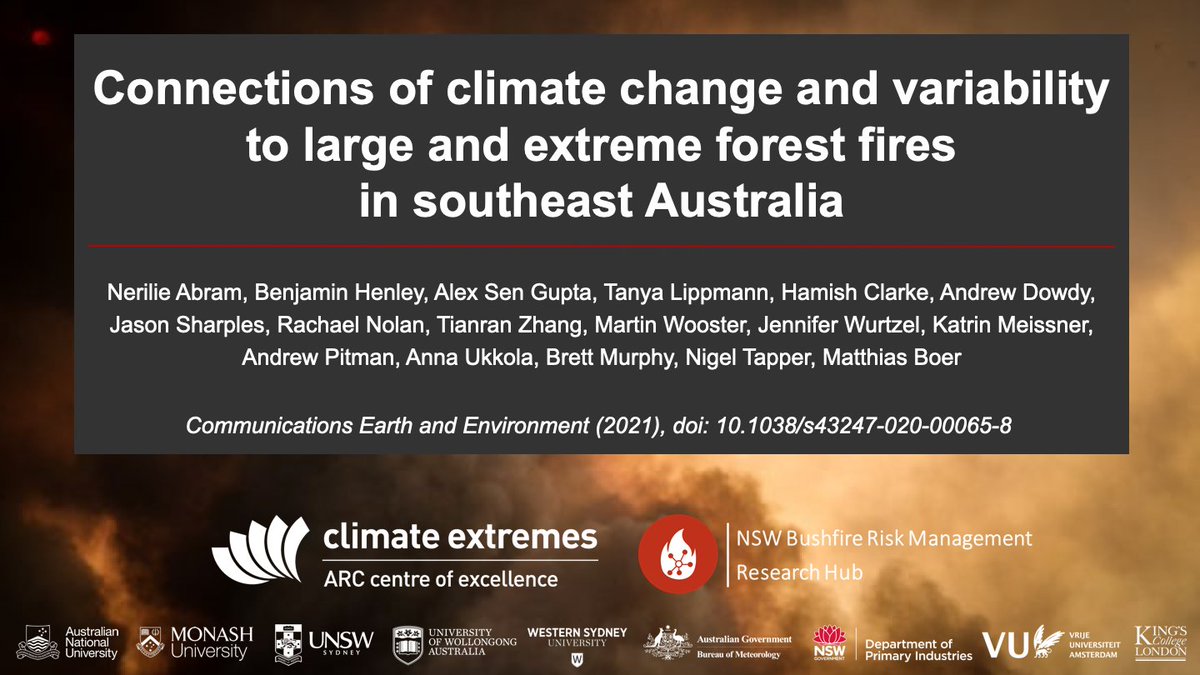
The #BlackSummer fires were unprecedented:
*In their scale (23% of all southeast Australia forests were burnt)
*In their power (for every month of the spring and summer seasons), and
*In the number of fires that developed into extreme pyroconvective events
*In their scale (23% of all southeast Australia forests were burnt)
*In their power (for every month of the spring and summer seasons), and
*In the number of fires that developed into extreme pyroconvective events
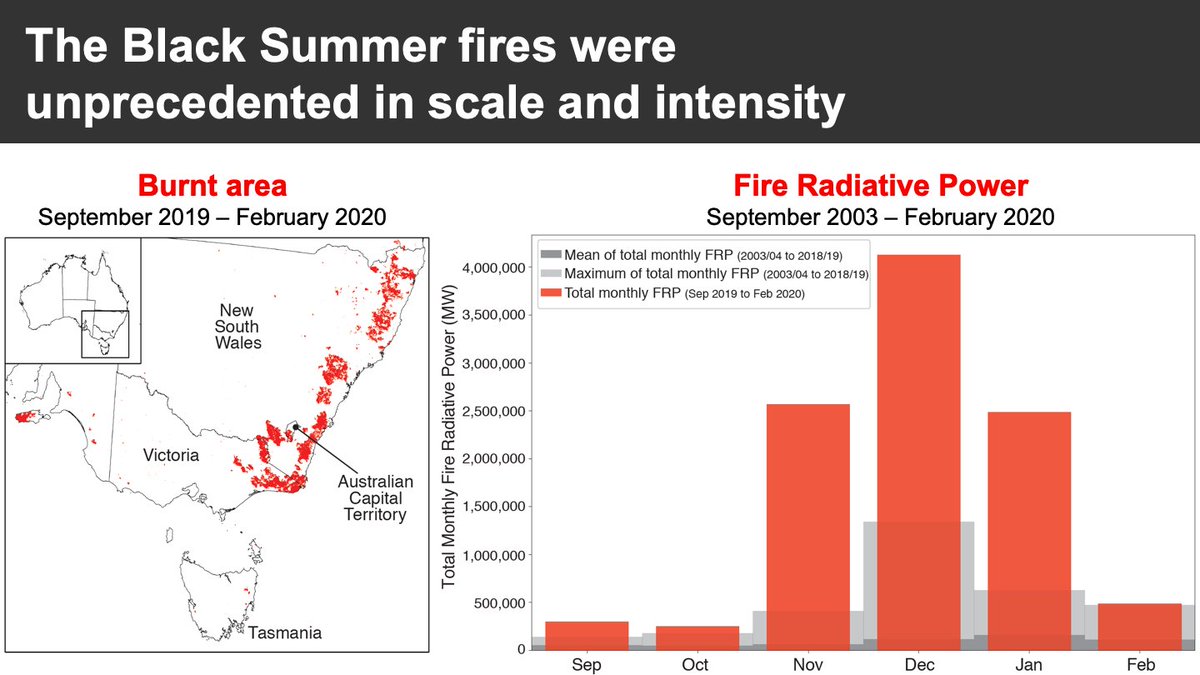
Climate in SE Australia in 2019 was also the hottest and driest on record.
Regional warming is part of human-caused global warming trend.
Dry conditions were part of a 3-year drought with consecutive winter rain failures. Long-term winter drying trend appears to be emerging.
Regional warming is part of human-caused global warming trend.
Dry conditions were part of a 3-year drought with consecutive winter rain failures. Long-term winter drying trend appears to be emerging.
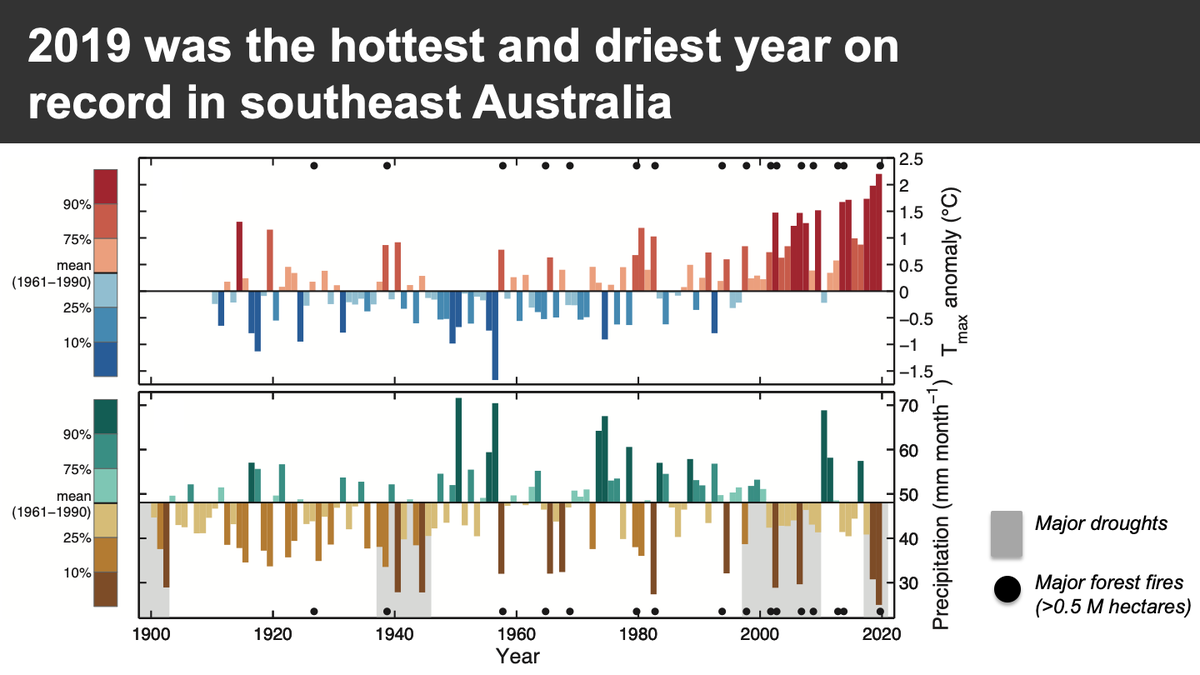
Dry years in southeast Australia are usually also hot, (and wet years are usually cool), due to land-atmosphere feedbacks.
And years of large bushfires in southeast Australia have clustered in the hot-&-dry quadrant of historical climate conditions
And years of large bushfires in southeast Australia have clustered in the hot-&-dry quadrant of historical climate conditions
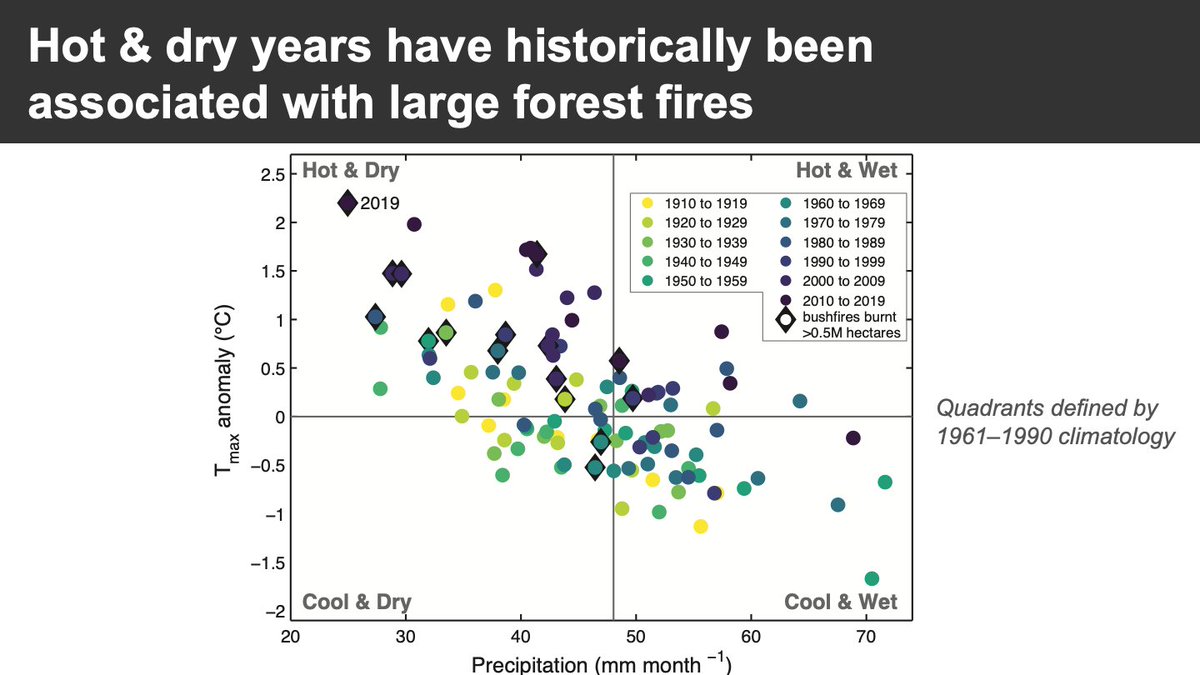
Climate variability also contributed to the extreme climate in 2019.
The phases of climate variability that increase fire risk in southeast Australia are El Niño events, positive Indian Ocean Dipole events, and a negative Southern Annular Mode in the warm season.
The phases of climate variability that increase fire risk in southeast Australia are El Niño events, positive Indian Ocean Dipole events, and a negative Southern Annular Mode in the warm season.
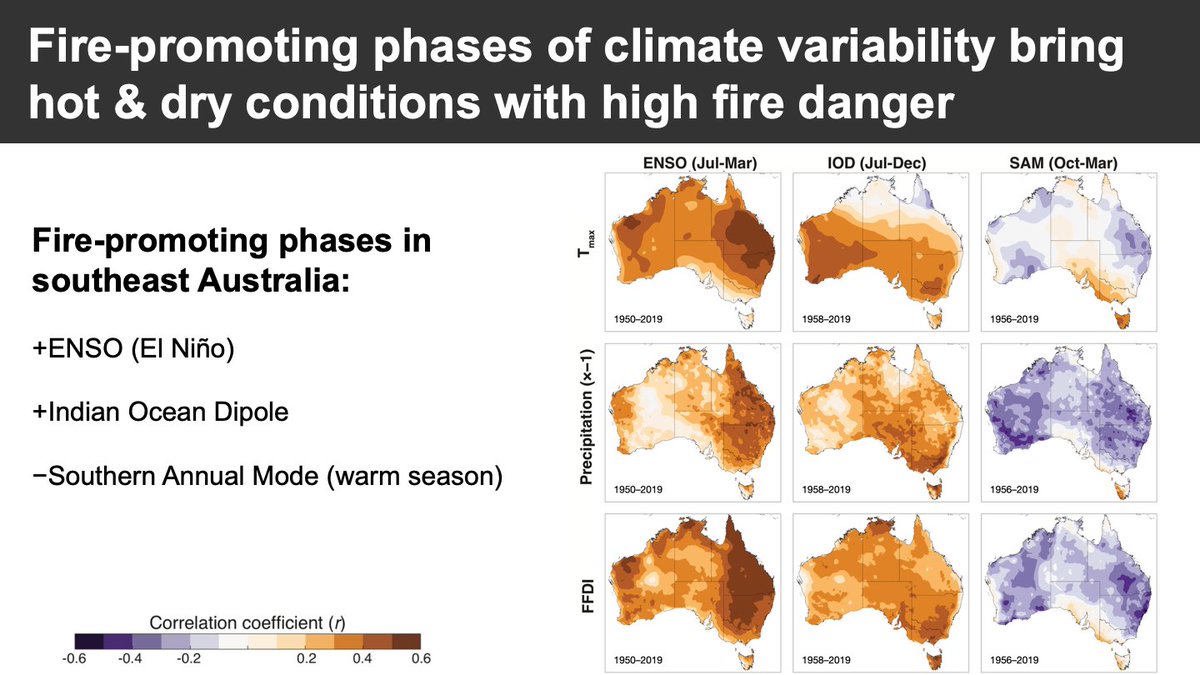
Having two or more of the climate modes have been in their fire-promoting phase significantly increases the risk of large fires.
In 2019 the compound effects of +IOD and -SAM increased the extent and severity of fire risk in southeast Australia.
In 2019 the compound effects of +IOD and -SAM increased the extent and severity of fire risk in southeast Australia.
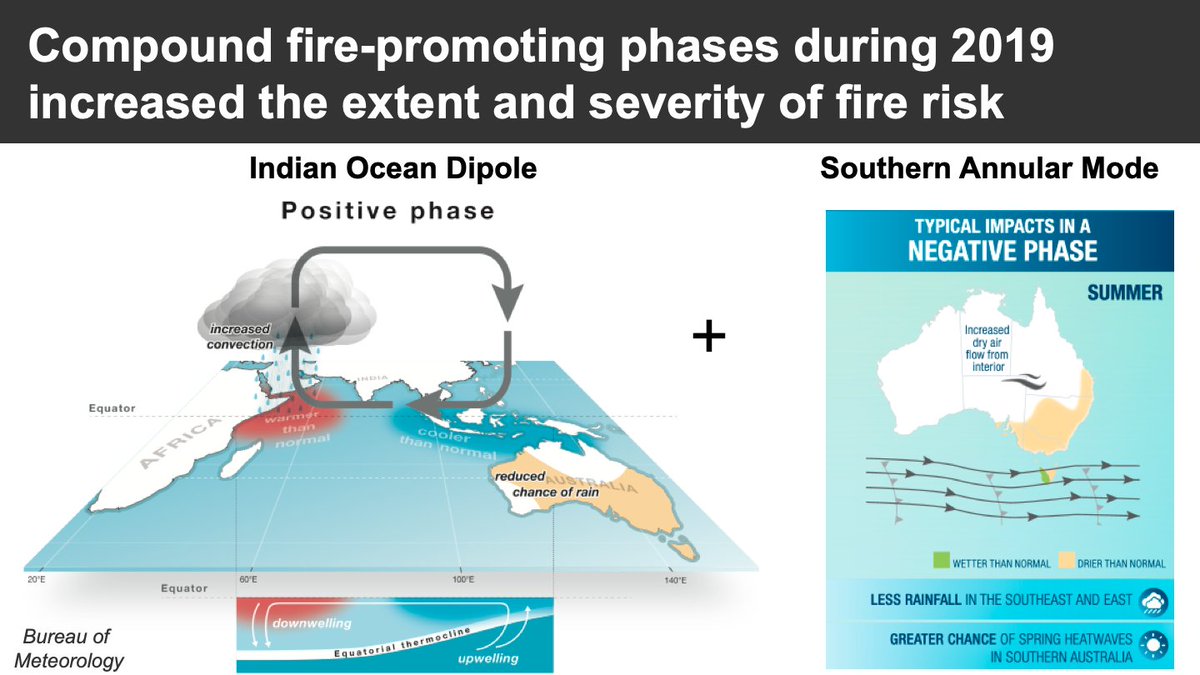
But climate variability is also being altered by climate change.
Fire-promoting phases of tropical climate variability have now become more frequent than any time in the last several hundred years.
Fire-promoting phases of tropical climate variability have now become more frequent than any time in the last several hundred years.

In Australia, the forest fire danger index (FFDI) is used to describe fire risk.
High FFDI reflects conditions where fuels burn readily and dangerous fire weather make fire difficult to control.
High FFDI reflects conditions where fuels burn readily and dangerous fire weather make fire difficult to control.
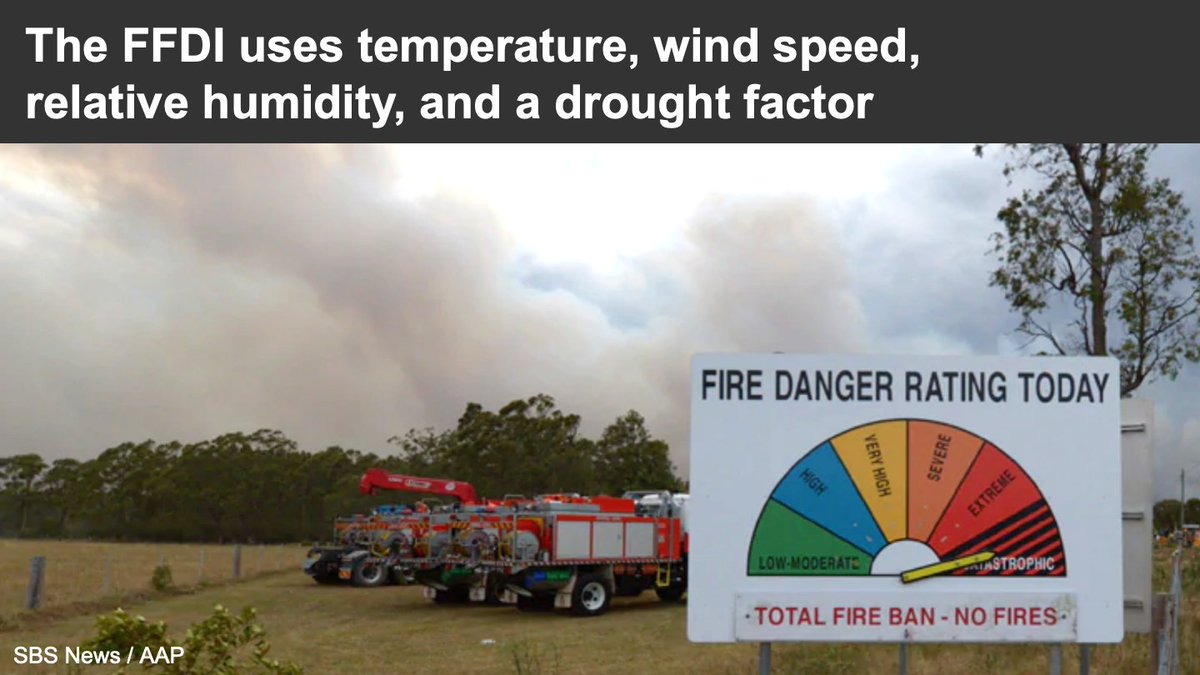
There are criticisms of the FFDI, including that it was developed using data from low intensity fires and prior to human-caused climate warming.
Despite this, FFDI has continued to be a good indicator of historical fires, including the #BlackSummer fires.
Despite this, FFDI has continued to be a good indicator of historical fires, including the #BlackSummer fires.
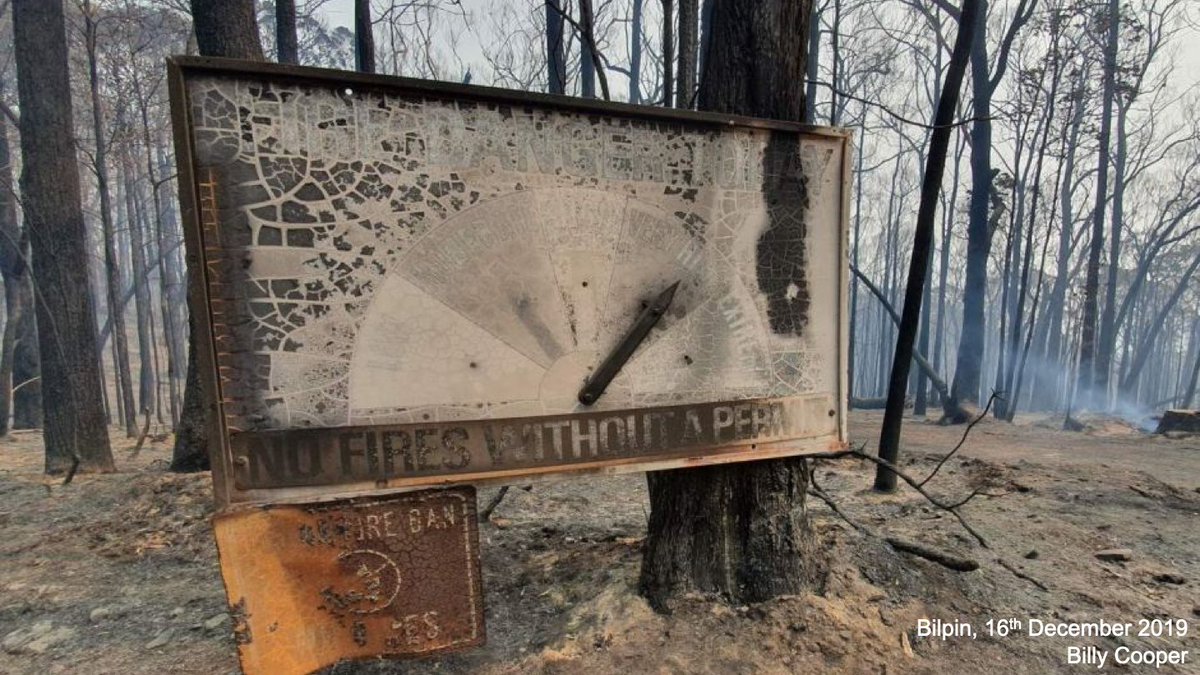
A linear increase in FFDI has been associated with an exponential intensification of fire radiative power.
Radiative power and FFDI in southeast Australia were both the highest ever recorded in December of 2019.
Radiative power and FFDI in southeast Australia were both the highest ever recorded in December of 2019.
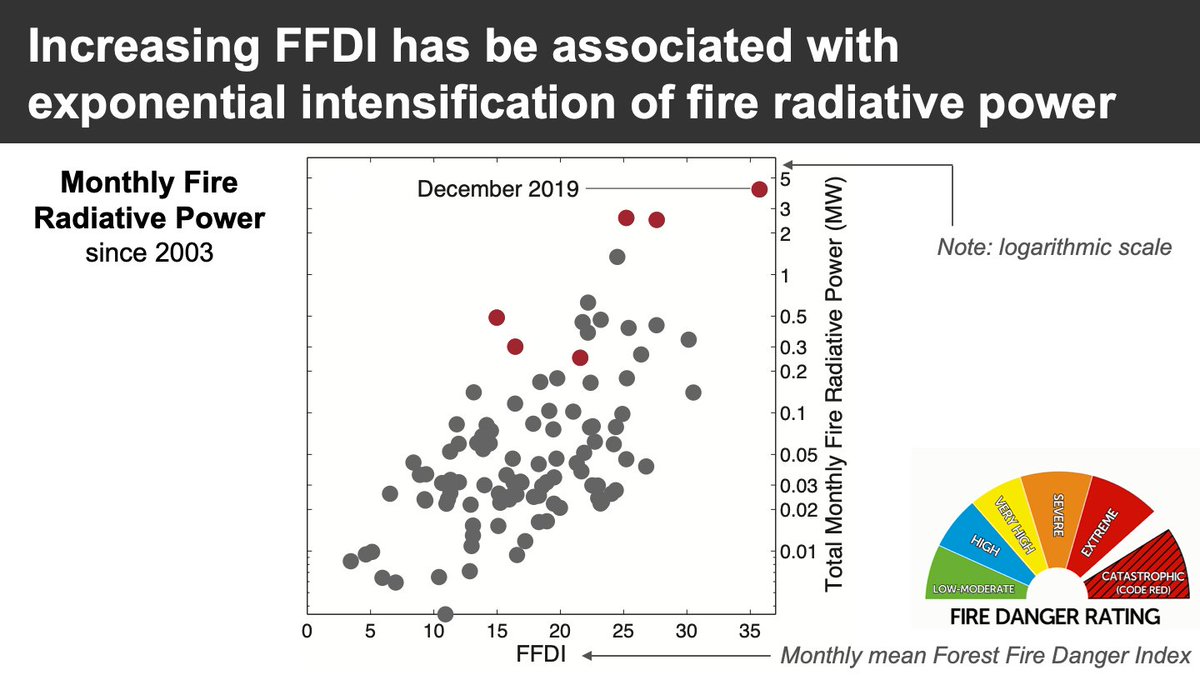
Unprecedentedly high FFDI during the #BlackSummer was also matched by:
*the largest forest burn area ever recorded, and
*the greatest number of extreme pyroconvective events ever observed.
*the largest forest burn area ever recorded, and
*the greatest number of extreme pyroconvective events ever observed.
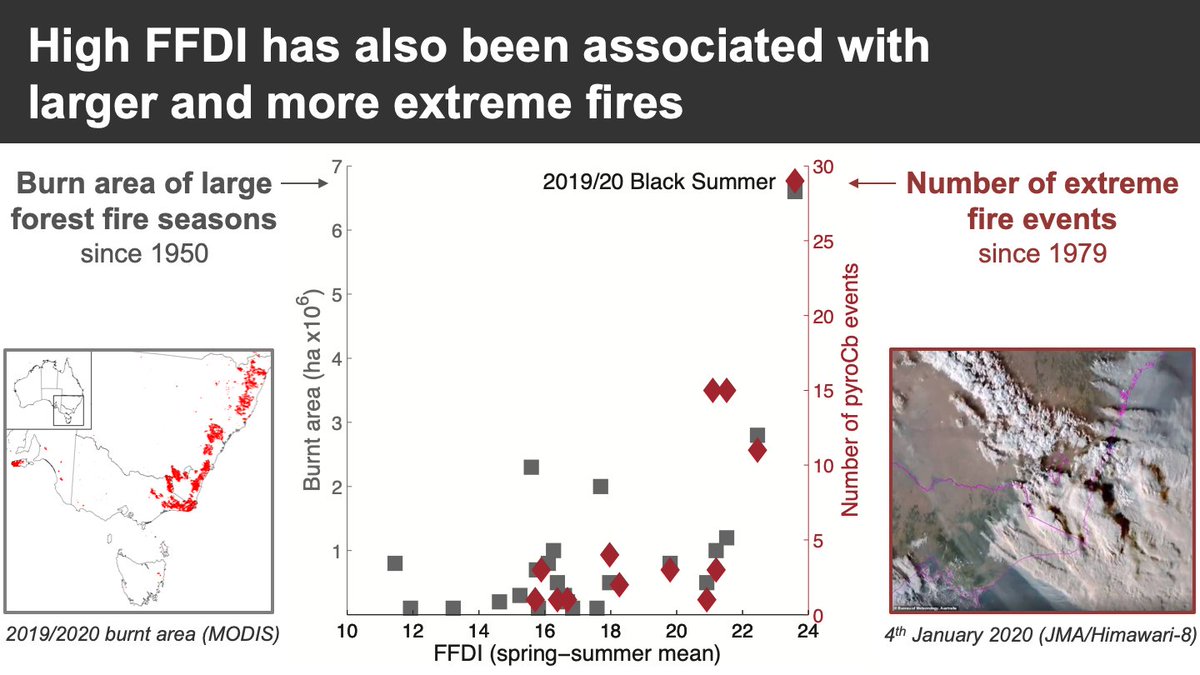
Forest fire danger in SE Australia has now emerged above the range of historical experience.
FFDI emergence is greatest in spring/summer.
Emergence also evident in Vapour Pressure Deficit – one of the prime factors linked to increasing fire risk in other parts of the world.
FFDI emergence is greatest in spring/summer.
Emergence also evident in Vapour Pressure Deficit – one of the prime factors linked to increasing fire risk in other parts of the world.
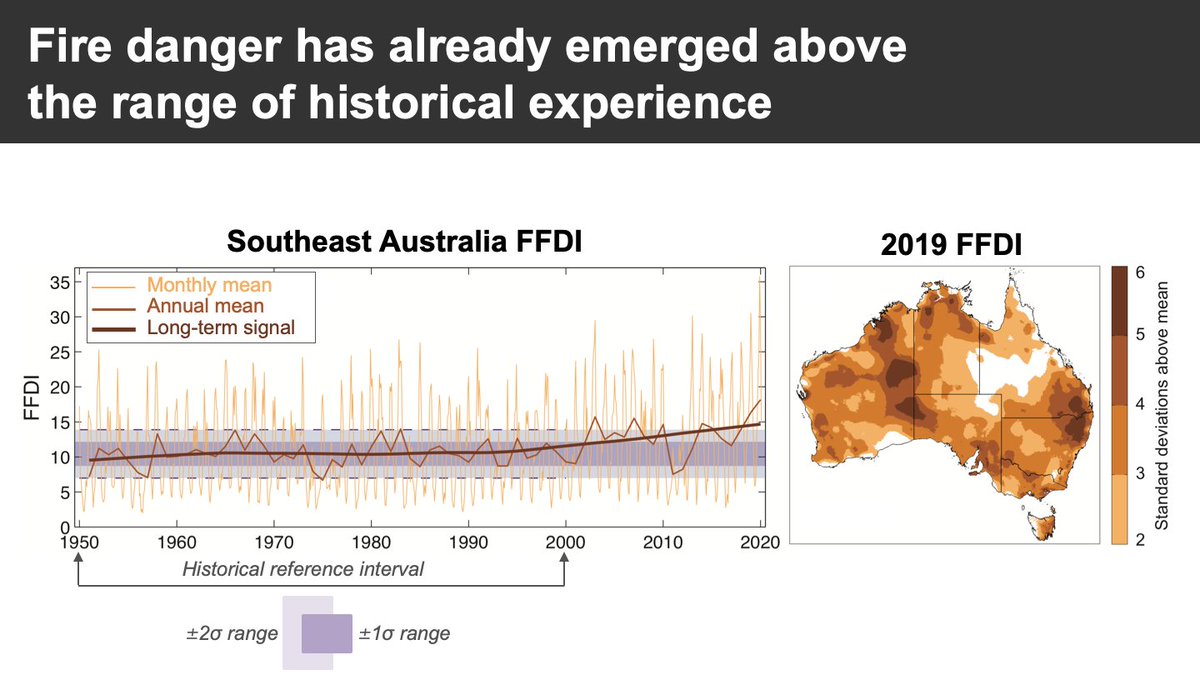
The observed signal of emergence suggests that predictions made more than a decade ago of a directly observable effect of climate change on fire danger in southeast Australia by 2020 have indeed eventuated. 
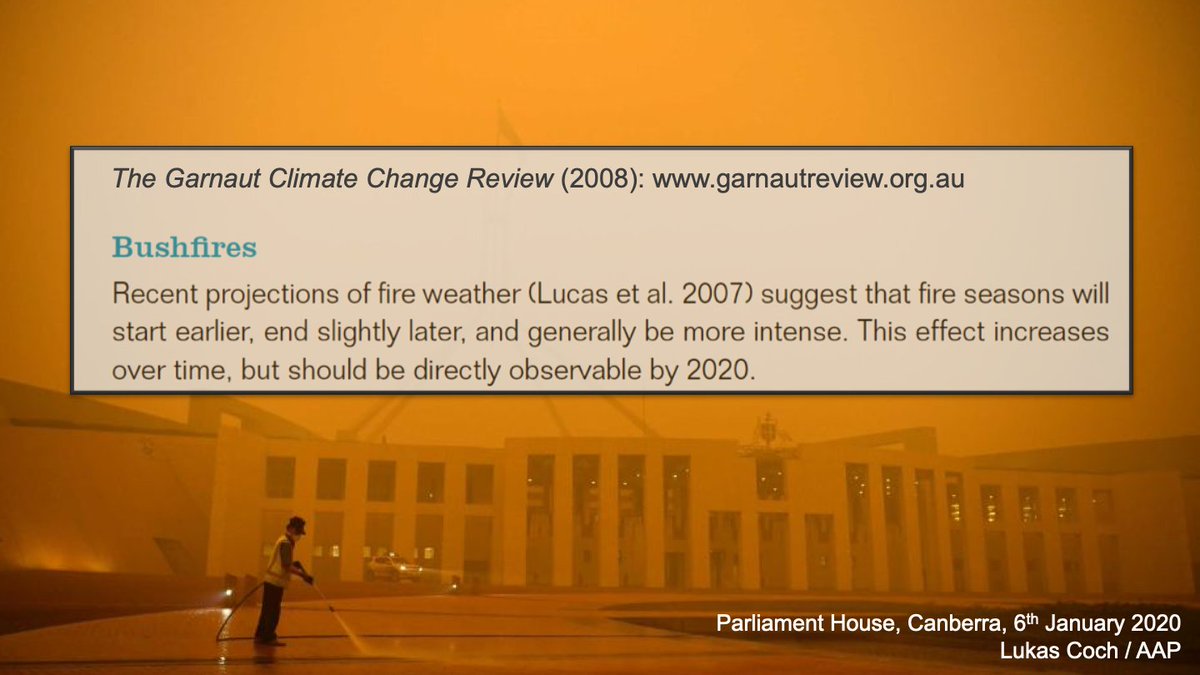
Looking to the future, we then reviewed the various climate changes that are expected in southeast Australia.
Some of these changes are virtually certain, others still have moderate or only low scientific confidence.
Some of these changes are virtually certain, others still have moderate or only low scientific confidence.
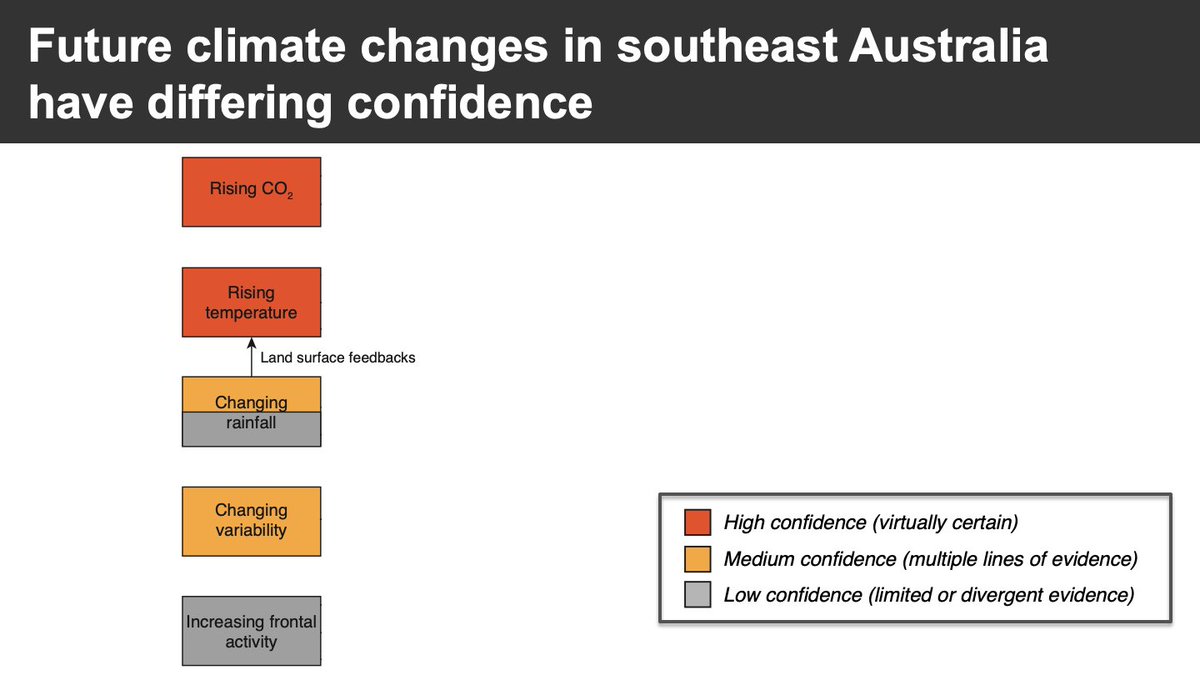
We then mapped how these climate changes would alter the essential ingredients (fuel load, fuel dryness, fire weather, ignition) needed for large forest fires.
Climate change is expected to increase fire risk in many ways, esp. through drier fuels and more dangerous fire weather
Climate change is expected to increase fire risk in many ways, esp. through drier fuels and more dangerous fire weather
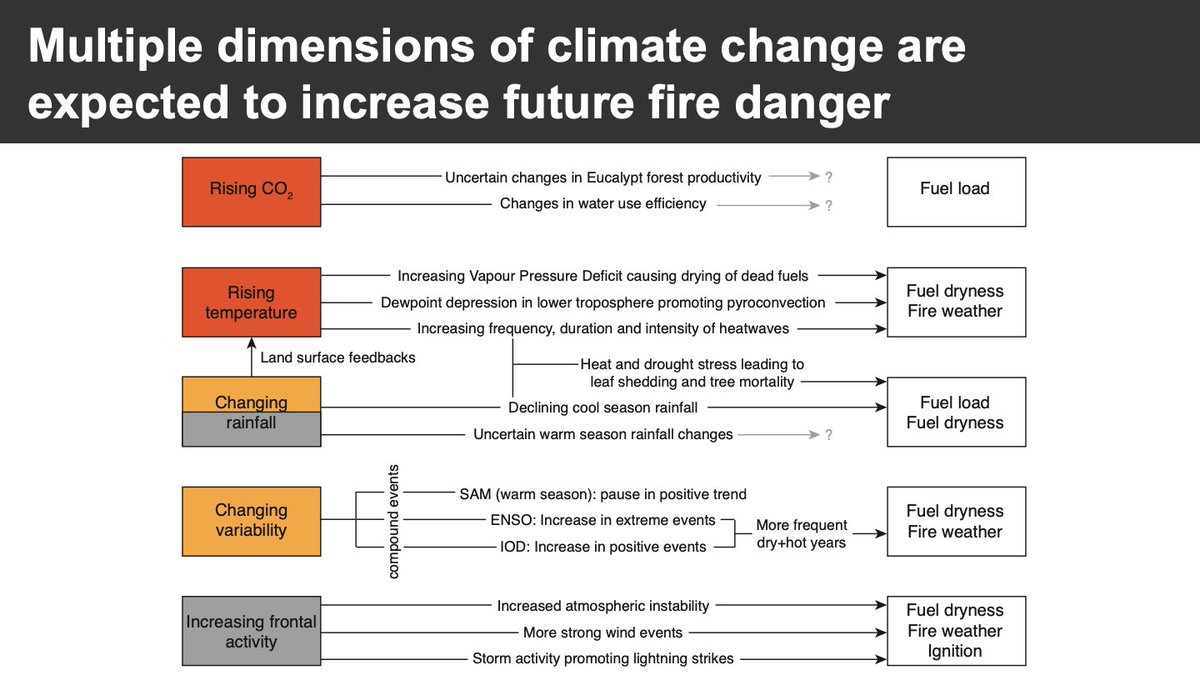
Most of the response to the Black Summer fires has focused on how to be better prepared for future fires.
But climate change will continue to increase fire risk in southeast Australia, possibly at a very rapid rate.
naturaldisaster.royalcommission.gov.au
But climate change will continue to increase fire risk in southeast Australia, possibly at a very rapid rate.
naturaldisaster.royalcommission.gov.au
A low greenhouse gas emission future would limit how much worse fire risk gets in the future, and give adaptation measures the best chance of success. 
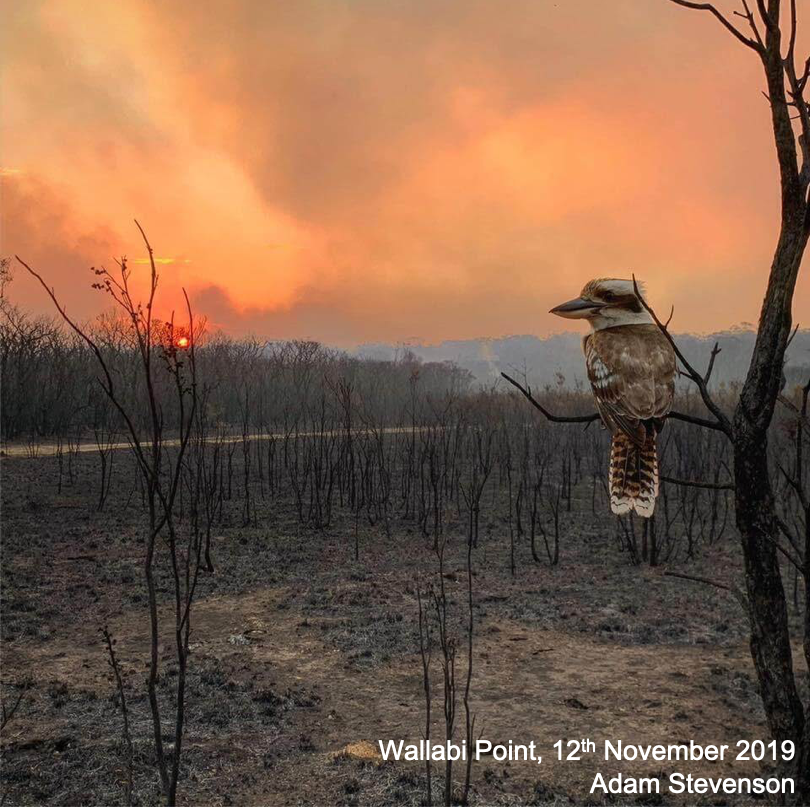
• • •
Missing some Tweet in this thread? You can try to
force a refresh




